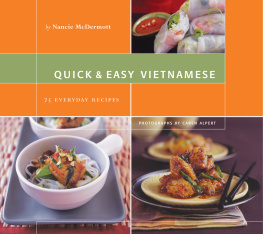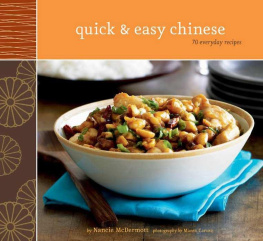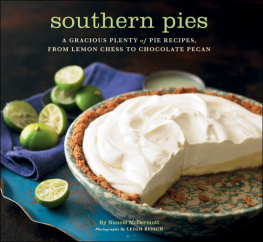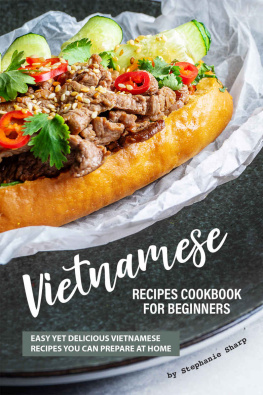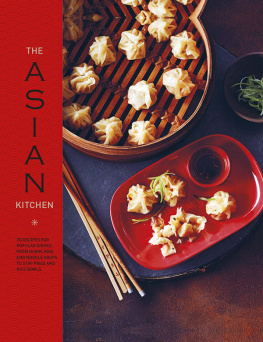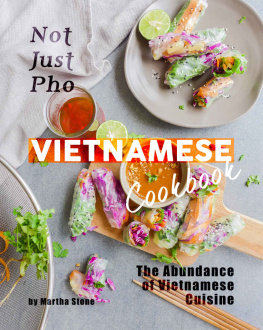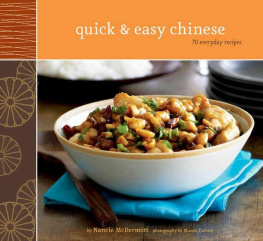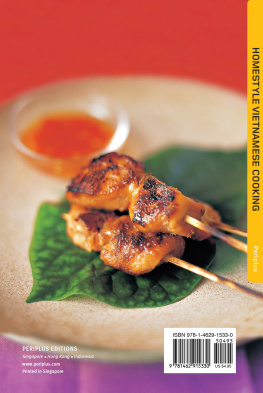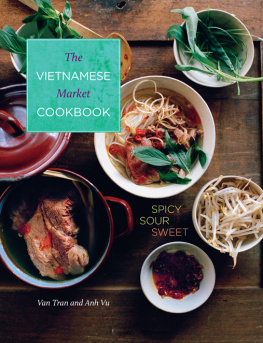
To my father, James Patrick McDermott, a magnificent, generous, brave, intelligent man, thanks to whom I love to read, travel, share, laugh, and linger at the table with family and friends.

From its craggy northernmost border with China to the lush paddy fields and coconut plantations of the Mekong Delta, Vietnam nurtures an extraordinary cuisine. The nations ancient Chinese heritage has formed a deep foundation for its culinary traditions. The cuisine of Vietnam is unique, however, distinct from that of China and of all its Asian neighbors, with which Vietnam shares so much in terms of climate, geography, and history.
With some 1,400 miles of seacoast, a vast network of rivers, and a sultry tropical climate, Vietnam nurtures vegetables galore, fragrant herbs, and luscious fruit. The Vietnamese kitchen celebrates this bounty with a fresh, delicate approach to food, bright with clear flavors and hearty with shellfish, fish, meat, noodles, and wraps. Simple, unseasoned rice anchors the food of Vietnam in East Asian fashion, but the good things cooked to go with it sparkle with Southeast Asias edible treasures: lemongrass, ginger, pineapple, and papaya team with fresh cilantro, mint, basil, and chilies to brighten every bite.
Contrasts prevail in Vietnamese cuisine: Sour flavors are balanced by salty ones, and sweet notes are answered by a little heat from ground pepper and chilies. If the fish is fried crisp, the sauce served with it will be a smooth pure. Delicate summer rolls call for a thick and pungent sauce based on salt-preserved soybeans, an edible marriage of heaven and earth. When chicken curry appears on the table, with its velvety, spice-infused coconut sauce, so does its companion dish of lime juice, salt, and pepper, balancing the richness of the curry with clear notes of citrus and heat.
In Vietnam as in most of Asia, soup is a mainstay, served right along with the rice and other dishes, and enjoyed throughout the meal. Neither first course nor entre, soup is more like a beverage within a typical Western meal. Whether its a simple broth like Clear Soup with Catfish, Tomatoes, and Fresh Dill (), a bowl of soup provides a little break from the variously flavored dishes on the Vietnamese table.
As in China and East Asia, the Vietnamese eat their rice in bowls with chopsticks. And like these northern neighbors, they enjoy their meals seated around a table. In the rest of Southeast Asia, the way people eat reflects their cultural connections to India. In Thailand, Burma, Cambodia, and Laos, people dine seated on woven mats, eating their rice from a plate with spoons or the fingers of the right hand.
Like all their Southeast Asian neighbors, Vietnamese cooks make brilliant use of their countrys tropical bounty, from coconut milk, tamarind, and limes, to chilies, green mango, lotus stems, and a staggering array of fragrant and pungent fresh herbs. Vietnams cuisine veers from the beaten path of Southeast Asian cooking in numerous ways, however. Rather than stir-frying most vegetables with a handful of meat or other protein, cooks in Vietnam tend to let meat be meat and green be green. Vegetables are cooked simply: spinach is fried with garlic, and eggplant is grilled and then topped with a tangy clear sauce. Other vegetables appear raw, cool, crisp, and ready for bundling into lettuce packets or rice wrappers, along with grilled meats, fish or seafood, a tangle of rice noodles, fresh herbs, and a splash of vibrant dipping sauce.
Meat often stands alone, minimally seasoned. It is briefly grilled as kebabs, meatballs, or in thin strips, and is served up with a pungent sauce. Meat and fish are also simmered briefly in a clay pot with fish sauce and sugar to make a kho dish, creating lots of delectable sauce to enjoy over rice. What in many places would be one persons serving of chicken, pork, or fish can therefore satisfy many guests. In addition to stretching a little protein to feed more people, a kho dish requires a minimum amount of fuel and effort.
The ingredients for cooking Vietnamese food are easy to come by these days in the West. Fish sauce, rice noodles, and rice papers for wraps and rolls can be found in any Asian market, or through the mail-order and . Now that soy sauce, Asian sesame oil, and hoisin sauce are widely available in major supermarkets, you can often buy the condiments you will need for cooking delicious Vietnamese dishes in one trip to your local grocery store. Add some meat, fish, shellfish, or a vegetarian protein source to your shopping cart, along with a big jar of roasted peanuts and a small one of sesame seeds, and then head for the produce section. Toss in some leaf lettuce, limes, carrots, scallions, onions, and garlic. Then top it all off with a bouquet of fresh cilantro or mint, and head for the check-out counter.
Vietnamese cuisine survived more than a century of French colonial presence beautifully, moving into the postcolonial world and now the new millennium with her culinary identity clear and strong. Vietnams cuisine has remained quite Vietnamese, even while clearing a space for the affectionate adoption of a few worthy French traditions, notably good strong coffee, crme caramel, and baguettes freshly baked every day.
You wont need much in the way of new equipment to cook the quick and easy Vietnamese food featured here. A big deep skillet will work as well as a wok; a good chefs knife will chop as well as an Asian cleaver; and a pair of V-shaped stainless steel tongs will usually stand in nicely for the more traditional cooking chopsticks.
Vietnams cooking techniques tend to be straightforward and easily translated to a Western kitchen. Grilling is a national pastime. While the practice of marinating meats before grilling is common, the time required tends to be measured in minutes rather than hours.
Noodles rule in Vietnam, and once you get used to the simple basics of cooking them, you will be putting together fine noodle feasts: big, delicious bowls of soup noodles; tasty stir-fries; fast, fresh noodle salads; and countless noodle-centered wrap-it-up meals. These dishes start with a platter of quickly grilled or roasted chicken, pork, beef, salmon, shrimp, tofu, or portobello mushrooms, cooked at home or carried in from the deli. The meat or vegetable is paired with a supply of lettuce cups, or softened rice- paper triangles, aromatic herbs, a tangle of rice noodles, and a bowl or two of brilliantly flavored sauces. Family and friends start picking and choosing, trying this herb and that sauce, relaxing and reviving, almost as though they were playing with their food.
The truth is, playing with food is a way of life in Vietnam. So is making flavor-packed meals quickly and simply, using what you have or can find easily on any given day. Some days I create a culinary masterpiece worthy of an ovation. Most days, though, I have more on my plate than fixing dinner, but I long for something tasty and freshly made, interesting but not too complicated, something I can step away from if the phone rings, or homework issues arise, or the dog begs to go out. I want to make something satisfying, and good enough to make my whole family start to smile. Quick & Easy Vietnamese is filled with this kind of food, along with a few dazzlers for the occasional tour de force when you have lots of helping hands.
If you enjoy Vietnamese food already, look up your favorites. If you are new to Vietnamese flavors, browse through the recipes and find something that sounds good. Make a grocery list, drop by the supermarket, and start cooking. You will love the delicate feast of Vietnamese cooking the quick and easy way.
Next page
